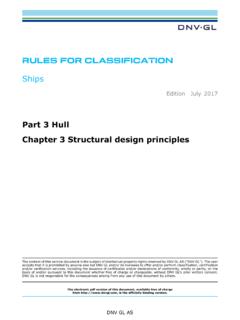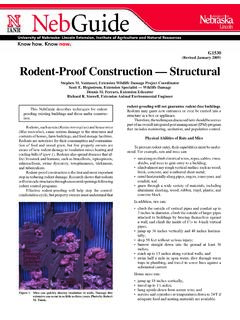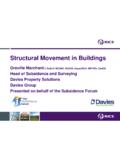Transcription of CHAPTER 5 - FOUNDATION REQUIREMENTS
1 CHAPTER 5 - FOUNDATION REQUIREMENTS 500. GENERAL. This section outlines general material and quality standards for all foundations in this manual. 501. EXCAVATION 501-1. FOOTING DEPTH. Excavation for footings or FOUNDATION walls shall extend below depth of soil subjected to seasonal or character-istic volume change to undisturbed soil that provides adequate bearing. Select the greatest depth required by any of the provisions below, reference Figure 5-1. A. Maximum Frost Penetration Depth. The bottom of footings shall extend at least to the depth indicated on the map on page H-4.
2 B. Alternate Seasonal Wetting and Drying. This is especially important with ex-pansive soils. If expansive soils exist, consult a geotechnical engineer to obtain required foot-ing depth. C. Footing Depth. The footings shall be deep enough to provide required uplift capac-ity. (This value may need to be determined for high wind areas after the calculations needed to determine footing bearing have been com-pleted.) 502. FOUNDATION MATERIALS. Footings and foundations shall be constructed of solid materials such as masonry, concrete, or treated wood, based on the FOUNDATION Design Concept Selection (Appendix A) and Founda-tion Capacity Tables.
3 (Appendix C) (For ma-sonry and concrete refer to CABO , and ; for wood refer to CABO and ) 503. structural REQUIRE-MENTS 503-1. FOUNDATION REQUIREMENTS . All exterior walls, marriage walls, marriage wall posts, columns and piers, must be sup-ported on an acceptable FOUNDATION system that must be of sufficient design to support safely the loads imposed, as determined from the character of the soil. A. Height Above Grade. FOUNDATION walls shall extend at least 8" above the finished grade adjacent to the FOUNDATION at all points. See Figure 5-1.
4 B. Minimum FOUNDATION Wall and Wall Footing Thickness. For masonry or concrete construction, the minimum FOUNDATION wall will be 6 inches. The minimum reinforced concrete footing thickness will be 6 inches or 1-1/2 times the length of the footing projection from the FOUNDATION wall, whichever is greater. 503-2. PIER AND COLUMN FOOTING REQUIREMENTS . Footings for pier founda-tions shall be reinforced concrete and should be placed level on firm undisturbed soil of ade-quate bearing capacity and below the frost penetration depth. They can also be placed on engineered, compacted fill, approved by a li-censed geotechnical engineer.
5 A. Unusual Conditions. Where unusual conditions exist, the spacing of piers and pier size and the load bearing capacity of the soil shall be determined specifically for such condi-tions. 5 - 1 B. Minimum Pier and Pier Footing Thickness. The minimum thickness for a pier is 8 inches. The minimum thickness for pier footings is 8 inches or 1-1/2 times the length of the footing projection from the pier, whichever is greater. 503-3. FOOTING REINFORCING (HORIZONTAL). Reinforce footings when the projection on each side of the wall, pier, or column exceeds 2/3 of the footing thickness, or when required because of soil conditions.
6 503-4. MASONRY PIERS AND WALLS. All masonry piers and walls shall have mor-tared bed and head joints. Reinforcing and grouting shall be in accordance with the foun-dation concept selected from Appendix A and designed in Appendix C. 503-5. CRAWL SPACE REQUIRE-MENTS (Basementless spaces) A. Height Requirement. Ground level must be at least 18 inches below bottom of wood floor joists and 12 inches below bottom of chassis beam. Where it is necessary to pro-vide access for maintenance and repair of me-chanical equipment located in the under floor space, the ground level in the affected area shall not be less than 2 feet below wood floor joists.
7 (Refer to CABO, Section R-309.) See Figure 5-1. B. Interior vs. Exterior Ground Level. The interior ground level must be above the outside finish grade unless: 1. Adequate gravity drainage to a posi-tive out fall is provided, or 2. The permeability of the soil and the location of the water table is such that water will not collect in the crawl space, or 3. Drain tile and automatic sump pump system are provided. C. Openings. Locations of crawl space openings and ventilation openings should be on long FOUNDATION walls. Avoid any openings on short FOUNDATION walls.
8 Sill plates or other structural members should not be randomly cut to accommodate openings. Continuity of struc-tural members must be maintained. Minimum Clearances and Footing Depth Figure 5 - 1 5 - 2 503-6. FOUNDATION WALLS FOR BASEMENTS. The design and reinforcing of basement walls is NOT in the scope of this document. Refer to local codes and ordinances for guidance. Refer also to CABO, Section R-304: " FOUNDATION Walls." Design the unit s FOUNDATION based on soil conditions present at the site. 503-7. BACK FILL. Material used for back fill must be clean and free of wood scraps or other deleterious substances and must be placed carefully against walls.
9 503-8. STEEL BEAMS AND COLUMNS. The analysis and design of steel transverse girders, steel longitudinal girders potentially used under marriage walls to reduce the num-ber of steel pipe columns within a basement, and the steel pipe columns themselves are NOT within the scope of this document for system Types E5, E6 and E7 5 - 3

















